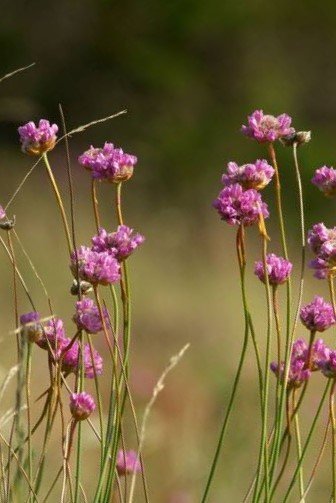 Image 1 of 2
Image 1 of 2

 Image 2 of 2
Image 2 of 2



Armeria maritima (Sea Thrift)
Our true native species- not a cultivar! Sea Thrift survives well in poor, shallow soils and does well in the thin, fast-draining soils of our native South Salish prairies or on or near beaches.
This low-growing evergreen perennial produces 4 in.-tall dense mounds that can slowly spread to 8-12 in. In mid-spring, round clusters of many tiny pink to white flowers rise several inches above the foliage, held aloft on slender stalks, and providing an important nectar source for native butterflies and other pollintors. Following the initial flush of abundant blooms, expect additional sporadic flowering throughout summer, especially if dead-headed.
Pair this lovely native perennial with other native and water-wise perennials that also thrive in full sun and dry, well-drained soils.
Our true native species- not a cultivar! Sea Thrift survives well in poor, shallow soils and does well in the thin, fast-draining soils of our native South Salish prairies or on or near beaches.
This low-growing evergreen perennial produces 4 in.-tall dense mounds that can slowly spread to 8-12 in. In mid-spring, round clusters of many tiny pink to white flowers rise several inches above the foliage, held aloft on slender stalks, and providing an important nectar source for native butterflies and other pollintors. Following the initial flush of abundant blooms, expect additional sporadic flowering throughout summer, especially if dead-headed.
Pair this lovely native perennial with other native and water-wise perennials that also thrive in full sun and dry, well-drained soils.
Our true native species- not a cultivar! Sea Thrift survives well in poor, shallow soils and does well in the thin, fast-draining soils of our native South Salish prairies or on or near beaches.
This low-growing evergreen perennial produces 4 in.-tall dense mounds that can slowly spread to 8-12 in. In mid-spring, round clusters of many tiny pink to white flowers rise several inches above the foliage, held aloft on slender stalks, and providing an important nectar source for native butterflies and other pollintors. Following the initial flush of abundant blooms, expect additional sporadic flowering throughout summer, especially if dead-headed.
Pair this lovely native perennial with other native and water-wise perennials that also thrive in full sun and dry, well-drained soils.
